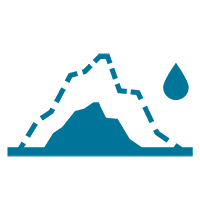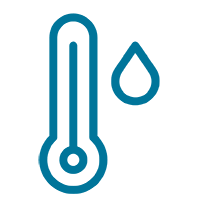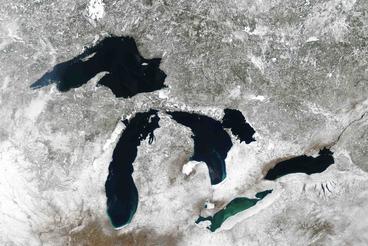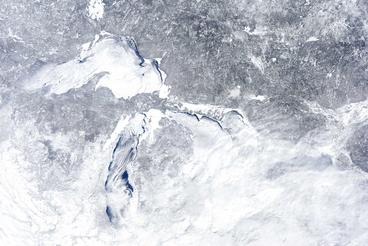Our Changing Lakes & Coastlines
The name "Minnesota" derives from a Dakota name, Miní Sóta Makhóčhe, which means "land where the water is so clear it reflects the sky."
Minnesota is known as the "Land of 10,000 Lakes", but the state actually has 11,842 lakes and almost 70,000 miles of lakes and streams. From the original Dakota name to today, the state's waterways have been a critical part of its culture, history, and economy. The lakes and streams across the state are used for recreation, transportation, drinking water, irrigation, agriculture, and industry. In addition, the nearby Great Lakes help to moderate Minnesota's climate.
Some of the effects of climate change on Minnesota's lakes include:




All of these changes can impact aquatic species.

(source: NOAA Great Lakes Environmental Research Laboratory)

(source: NOAA Great Lakes Environmental Research Laboratory)
Consequences
References & Suggested Reading
Brown, H., 2015: "Good Question: How did Minnesota get its name?" CBS Minnesota. URL.
Great Lakes Climate and Water Movement. Earth Systems – Education Activities for Great Lakes Schools (ES-EAGLS). 1996. Series EP-085. Ohio Sea Grant. Ohio State University, Columbus, OH 43212. 33-45. Authors: Fortner, RW, Miller, H, Sheaffer, AL
Harding, K. J., and P. K. Snyder, 2014: Examining future changes in the character of Central U.S. warm-season precipitation using dynamical downscaling. Journal of Geophysical Research: Atmospheres, 119, doi:10.1002/2014JD022575.
Harding, K. J., and P. K. Snyder, 2015: Using dynamical downscaling to examine mechanisms contributing to the intensification of Central U.S. heavy rainfall events. Journal of Geophysical Research: Atmospheres, 120, doi:10.1002/2014JD022819.
Melillo J., T. Richmond, and G. Yohe, 2014: An assessment from the U.S. Global Change Research Program to inform the public with scientific information and methods regarding climate change.
Michigan Sea Grant, 2021: "Microclimates." URL.
Minnesota Environmental Quality Board, 2014: Minnesota and climate change: Our tomorrow starts today. Report. URL.
Hoff, M., 2020: 2020 State Water Plan: Water and Climate. Report. URL.
Phillips, D.W., and J.A. McCulloch, 1972: The Climate of the Great Lakes Basin. Environment Canada, Atmospheric Environment, 20, doi:10.7202/021275.
Twincities.com, 2017: "Here are 10 maps of Minnesota's 10,000 lakes (and rivers, too)." URL.
University of Minnesota, American Indian Studies, 2021: "On Purpose: Portrait of American Indian Studies." URL.
USGCRP, 2018: Impacts, Risks, and Adaptation in the United States: Fourth National Climate Assessment, Volume II [Reidmiller, D.R., C.W. Avery, D.R. Easterling, K.E. Kunkel, K.L.M. Lewis, T.K. Maycock, and B.C. Stewart (eds.)]. U.S. Global Change Research Program, Washington, DC, USA, 1515 pp. doi: 10.7930/NCA4.2018.


